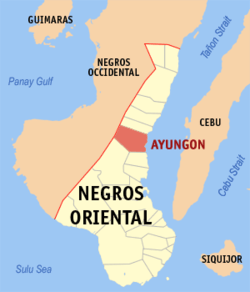Ayungon
| Ayungon | |
|---|---|
| Municipality | |
 Map of Negros Oriental with Ayungon highlighted | |
.svg.png) Ayungon Location within the Philippines | |
| Coordinates: 09°51′N 123°08′E / 9.850°N 123.133°ECoordinates: 09°51′N 123°08′E / 9.850°N 123.133°E | |
| Country | Philippines |
| Region | Negros Island Region (NIR/Region XVIII) |
| Province | Negros Oriental |
| Congr. district | 1st district of Negros Oriental |
| Barangays | 24 |
| Government[1] | |
| • Mayor | Edsel G. Enardecido |
| • Vice Mayor | Erwin Agustino |
| Area[2] | |
| • Total | 265.10 km2 (102.36 sq mi) |
| Population (2010)[3] | |
| • Total | 46,146 |
| • Density | 170/km2 (450/sq mi) |
| Time zone | PST (UTC+8) |
| ZIP code | 6210 |
| Dialing code | 35 |
Ayungon is a second class municipality in the province of Negros Oriental, Philippines. According to the 2010 census, it has a population of 46,146.[3]
History
It is said that Ayungon is derived from the name of a deaf man, “Ayung,” who cut down a “dungon” tree. Old municipal profiles refer to Ayungon as Todos los Santos though there are no legends to explain that Hispanic name, just as there are no tales elaborating on the ruins of apparently Hispanic fortifications on the Tampocon II shoreline, perhaps because Ayungon’s colonial past was not entirely its own: for many years it was a mere barrio of Tayasan, until 1924 when Governor General Leonard Wood came to establish Ayungon as a full-fledged municipality.
Although firing up its economic dynamos to catch up with provincial developments, Ayungon retains its rural charm through vast and scenic rice fields, dense coconut groves and expansive plantations of sugar cane, bananas and pineapple.
Of only three virgin forests said to be still remaining on Negros Island, one is located in Banban, Ayungon. Nature lovers will be regaled by sightings in the Karalaon Bird Sanctuary, the subterranean drama of the Mabato Caves, and the postcard-pretty Pagsalsalan Twin Falls.
Ayungon is located on the midriff of Oriental Negros’ northern stretch, approximately two hours from Dumaguete City.[4]
Barangays
Ayungon is politically subdivided into 24 barangays.[2]
- Amdus
- Anibong
- Atabay
- Awa-an
- Ban-ban
- Calagcalag
- Candana-ay
- Carol-an
- Gomentoc
- Inacban
- Iniban
- Jandalamanon
- Kilaban
- Lamigan
- Maaslum
- Mabato
- Manogtong
- Nabhang
- Poblacion
- Tambo
- Tampocon I
- Tampocon II
- Tibyawan
- Tiguib
Demographics
| Population census of Ayungon | ||
|---|---|---|
| Year | Pop. | ±% p.a. |
| 1990 | 33,317 | — |
| 1995 | 36,928 | +1.95% |
| 2000 | 40,744 | +2.13% |
| 2007 | 42,643 | +0.63% |
| 2010 | 46,146 | +2.91% |
| Source: National Statistics Office[3] | ||
References
- ↑ "Municipalities". Quezon City, Philippines: Department of the Interior and Local Government. Retrieved 12 March 2013.
- 1 2 "Province: Negros Oriental". PSGC Interactive. Makati City, Philippines: National Statistical Coordination Board. Retrieved 12 March 2013.
- 1 2 3 "Total Population by Province, City, Municipality and Barangay: as of May 1, 2010" (PDF). 2010 Census of Population and Housing. National Statistics Office. Retrieved 12 March 2013.
- ↑ Negros Oriental Tourism "", About | Cities & Towns. Retrieved 2013-05-28.
External links
- Philippine Standard Geographic Code
- Philippine Census Information
- Official Website
- Local Governance Performance Management System
 |
Himamaylan, Negros Occidental | Tayasan |  | |
| Kabankalan, Negros Occidental | |
Tañon Strait | ||
| ||||
| | ||||
| Mabinay / Bindoy |
| ||||||||||||||